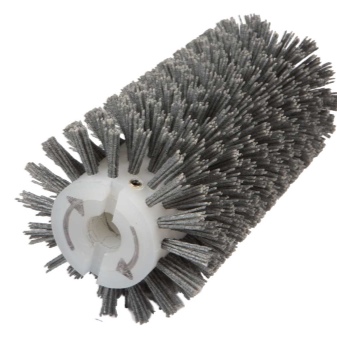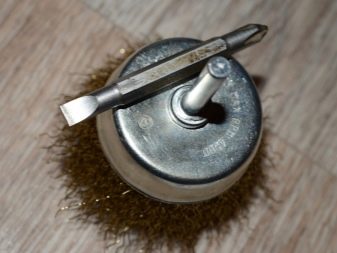Drill brushes: types, selection and application features

Every home craftsman dreams of a large number of electric assistants in his home. A drill has long become an almost mandatory attribute, because with its help you can not only drill a wall or knead a solution, but also make an ordinary electric meat grinder, use it as a mixer or build a fan. Therefore, the appearance of various brushes for a drill as attachments is quite natural: such devices greatly facilitate the life of a home craftsman.
The device and purpose of the attachments
Almost any nozzle is a rod that is inserted into the holder (chuck) of the drill. On the other side of the rod is the actual nozzle. If the nozzle is made for other tools (for example, a grinder), when the rod does not fit, use adapters, as well as adapters. It is important to carefully fix such a replaceable device as a nozzle in the chuck.


Brush heads have one or more purposes:
- grinding of various types of materials (metal, wood, concrete);
- cleaning metal products from scale and rust (brushed);


- removing old paint;
- polishing of various types of surfaces (wood, glass, metal, varnish coatings);
- removal of gumboils on concrete at the time of leveling the floor.


Varieties of brushes
Depending on the purpose and type of surface treatment of the brush are divided into several types.
- Polishing.
- Grinding.


- For removing dirt from flat surfaces or hard-to-reach places.
- For brushing wood.
- Machining welds.


According to the material used, they are divided into the following types:
- metal;
- foam rubber;


- abrasive polymer nylon;
- abrasive lamellar emery;
- felt.


At the same time, for the manufacture of brushes, the following is used:
- steel wire, if you want to process a metal surface;
- steel wire in the form of a corrugation, having different stiffness, determined by the diameter of the wire;


- braided steel - has increased hardness and self-sharpening effect;
- stainless steel for working with stainless steel and aluminum;
- brass wire for cleaning and grinding soft metals (bronze, copper), wood, texturing plastic;
- polymer abrasive - abrasive with a bristle based, for example, silicon carbide, used for finishing, roughing, texturing, rounding of edges.


Nozzle shapes
No matter how different the brushes are, they are all round. In shape, drill brushes have a fairly wide range.
- Radial, flat - for grinding metal, cleaning in hard-to-reach places, for example, in pipes.
- Plate really resembles a plate in shape. Available in plastic or rubber with bonded sandpaper for cleaning, polishing or sanding. To be able to hold the drill strictly above the surface to be treated, such a nozzle is attached to a pin with an adjustable fastening angle.


- Cylindrical (brushes) - used for narrow pipes in small and medium-sized areas. In addition, these conical tips are used for grinding or polishing jewelry or other precision work.
- Disc (circular, oval) - flat metal nozzles for processing large areas during repair or construction.Twisted steel filaments are capable of cleaning welded joints (seams and joints) and thoroughly polishing surfaces. The bristles are directed from the center to the edge of the disc.
- Cup (carpal) - differ in the presence of a container of different diameters, into which a very rigid steel wire is pressed - it can be of different lengths - or nylon pile, filled with molten plastic. Such brushes are used for descaling, removing paint from surfaces, removing concrete fluxes - irregularities, as well as for brushing wood.


- Drum - are a cylinder with attached sandpaper for polishing iron surfaces. And also it can be foam rubber (felt), microfiber for more delicate processing of wood, glass, metal.
- Fan (plate) brushes Is a disc with attached sandpaper plates perpendicular to the surface. Such an abrasive nozzle is convenient for cleaning and grinding surfaces of various geometries, since it is capable of changing its own shape when the drill is running.
- Petal - these are cylinders to which a metal abrasive bristle is attached. Used for removing paint, rye, burrs, polishing, cleaning, brushing.
- Conical - are a cross between disc and cup brushes. Designed to remove heavy dirt, paint, scale, burrs.


All these devices, created for stripping, grinding and having a strong effect on the surface through a rigid attachment, are called brushes or corners (cord brushes).
Features of use depending on the rigidity
Depending on the function performed, the attachments can be hard or soft. As a rule, soft materials are used for polishing, finishing cleaning of soft material. It can be foam rubber of different thickness, felt, microfiber for jewelry or sisal. A sisal brush is like a twisted rope attached to a cylinder or disc. Natural coarse fiber from palm leaves completes well the processing of wood after brushing (aging). Felt is used to polish paint and varnish coatings or bring metal to a shine.


Synthetic nylon is used in intermediate surface treatment. It is important not to overheat during operation - polymers begin to melt rather quickly.
Iron brushes are the toughest. And the thicker the wire, the more difficult the job will be done. The main section of the wire is approximately 5 millimeters. Corrugated and soft brass are used for finishing. Thicker than 5 millimeters - for initial processing.


Choice
When choosing drill bits, you need to determine the purpose of this purchase. If there is a lot of work and it is varied, for example, removing paint from the walls, brushing, grinding, polishing the floor, then it makes sense to buy a set of nozzles of different shapes and rigidity. These kits are sold at regular hardware stores. Their choice is great both in price and quality. The main thing is that you do not need to buy separate power tools: it is enough to buy attachments or adapters.


The practicality of such a purchase is determined by the wide variety of brushes: for any surface, hard-to-reach places, from any material. But do not forget that a home drill is not an industrial tool, so the efficiency will not be perfect. In addition, there may not be an adapter for some nozzle, there will not be enough power, the number of revolutions.

Why spark drill electric motor brushes
In any electric motor there are graphite (carbon) brushes. With constant friction, the mechanism is worn out, as a result of which the graphite dust settles on the collector. This is where sparking begins. As a result of abrasion, brush wear occurs - this is the second reason. If this happened to your drill, then it will slow down or the electric motor may not turn on. The third reason is the incorrect installation of the brushes in the brush assembly.


After disassembling the drill and visually checking the grooves of the brush assembly, you need to make sure that the device can still be used. Sparking is also possible when the stator fails, collector contacts are closed due to graphite dust, and contacts are contaminated with carbon deposits. In some cases, cleaning the brush assembly will help, and in others, replacing the brushes or brush springs. It will not be difficult to replace the worn part, and the drill will serve in the same mode.


Work safely with your drill
Sometimes the implementation of simple rules saves not only health, but also life. Therefore, when using a drill with an attachment, you must:
- make sure that the brush is selected correctly for the selected type of work;
- securely fix the rod into the drill chuck;
- hold the drill with both hands;


- at the beginning of work, test the brush on an insignificant surface so as not to damage it;
- regulate pressure;
- until the drill has completely stopped, do not turn on the reverse mode;
- after turning off the drill, do not touch the brush and the rod until it cools completely, in order to avoid burns;
- be sure to use personal protective equipment: gloves, goggles or mask, respirator when grinding, cleaning, polishing.
For information on how to choose the right brushes for a drill, see the next video.













The comment was sent successfully.